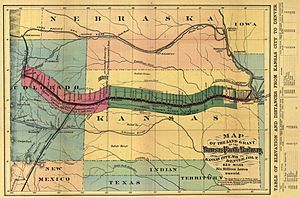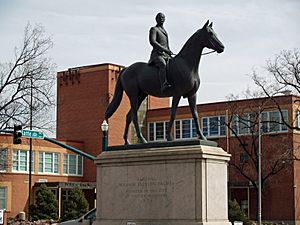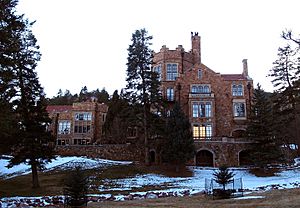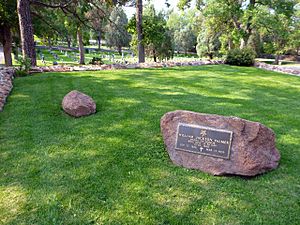William Jackson Palmer facts for kids
Quick facts for kids
William Jackson Palmer
|
|
|---|---|
 |
|
| Born | September 18, 1836 Leipsic, Delaware |
| Died | March 13, 1909 (aged 72) Colorado Springs, Colorado |
| Place of burial |
Evergreen Cemetery, Colorado Springs, Colorado
|
| Allegiance | United States Union |
| Service/ |
United States Army Union Army |
| Years of service | 1861–1865 |
| Rank | |
| Commands held | 15th Pennsylvania Cavalry |
| Battles/wars | American Civil War |
| Awards | Medal of Honor |
| Spouse(s) | Mary Lincoln Mellen |
| Other work | Founder of Colorado Springs, Colorado and builder of the Denver and Rio Grande Railroad |
William Jackson Palmer (born September 18, 1836 – died March 13, 1909) was an important American figure. He was a civil engineer, a brave soldier in the American Civil War, a successful businessman, and someone who gave a lot to charity. During the Civil War, he became a brevet brigadier general and earned the Medal of Honor for his actions.
Before the war, Palmer helped build railroads in Pennsylvania. His work was paused when the Civil War began. He served as a Union Army cavalry Colonel and was later recognized as a brevet Brigadier General. After the war, he helped fund education for formerly enslaved people in the South.
In 1867, Palmer moved West. He helped build the Kansas Pacific Railway. He also became good friends and business partners with Dr. William Abraham Bell from England. They are best known for starting the Denver and Rio Grande Railroad. This railroad and its later versions became the largest network of narrow gauge railroads in the United States.
Palmer and Bell were important because they helped introduce new ideas to American railroads. They promoted using coal instead of wood for train engines. They also pushed for narrow gauge railways. Palmer helped create industries related to railroads in Colorado, like a big steel mill near Pueblo. In 1871, he founded the city of Colorado Springs. He also started other communities. Palmer wanted Colorado Springs to be a "dry" town, meaning no alcohol, because of his Quaker and temperance beliefs. He supported colleges and helped start a hospital for people with tuberculosis. Schools in Colorado Springs were named after him and his wife, Mary "Queen" Palmer. A statue of William J. Palmer stands in downtown Colorado Springs today.
Contents
Early Life and Education
William Jackson Palmer was born in 1836 on a farm near Leipsic, Delaware. His family belonged to a group of Quakers who believed in peace. When he was five, his family moved to Germantown, near Philadelphia, Pennsylvania. He went to private and public schools there.
Starting a Career in Railroads
In 1851, at age 15, Palmer began working for the Hempfield Railroad in western Pennsylvania. Two years later, he worked under a chief engineer. He quickly learned about railroad construction.
His uncle, Frank H. Jackson, who led a coal company, encouraged Palmer to travel to England. He wanted Palmer to study coal mining and railroads. Palmer believed these would be very important for the United States. He was especially interested in whether train engines could run on anthracite coal instead of wood. In 1855, he spent six months in England. He wrote articles to pay for his trip. While there, he met famous railroad engineers and visited mines and mills.
In 1856, his uncle hired him at Westmoreland Coal Company. The next year, he worked for the Pennsylvania Railroad. He became a private secretary to its president, John Edgar Thomson. At this time, Andrew Carnegie, who would later become a famous industrialist, also worked there. Palmer wrote reports about using coal in locomotives. He learned a lot about running a railroad. His findings were key to changing how trains were fueled in the country. He also started working with Thomas A. Scott, who later managed military transportation during the Civil War.
Serving in the Civil War
When the American Civil War started in 1861, Palmer joined the Union Army. Even though his Quaker beliefs meant he disliked violence, he strongly opposed slavery. He felt he had to fight for what was right. He formed an independent cavalry company called the Anderson Troop in Pennsylvania. He was chosen as its captain. This troop served General Don Carlos Buell. Buell was impressed and asked Palmer to recruit more men.
In just ten days, Palmer recruited enough men to form a whole regiment, the 15th Pennsylvania Cavalry. He became its colonel. Before he could fully organize the regiment, he and some of his men were sent to help stop the Confederate invasion of Maryland in September. For almost a week, Palmer secretly gathered information about Confederate movements. He dressed in civilian clothes and sent his findings to General George B. McClellan using telegraphs.
After the Battle of Antietam, Palmer was captured while scouting. He was again in civilian clothes, trying to find out if Robert E. Lee's army was crossing the Potomac River. He was taken to Castle Thunder prison in Richmond, Virginia. His true identity was never discovered there. After four months, he was freed in a prisoner exchange.
Palmer rejoined his regiment in February 1863. The regiment had faced problems and some soldiers had refused to fight. Palmer reorganized them and appointed new officers. He got the charges against the soldiers dropped. The regiment then became very effective. They fought well in the 1863 Tullahoma Campaign, the Battle of Chickamauga, and the Franklin–Nashville Campaign.
At Chickamauga, Palmer's regiment guarded the Army of the Cumberland headquarters. When Confederates attacked, Palmer quickly gathered his men. They protected the Union artillery and helped the army retreat. General George H. Thomas praised Palmer's success in turning a discouraged group of men into strong soldiers.
Palmer actively chased Confederate General John Bell Hood after the Battle of Nashville in 1864. On March 9, 1865, President Abraham Lincoln nominated Palmer to become a brigadier general at age 28. The U.S. Senate approved this the next day. Palmer led a cavalry division in the final months of the war. His cavalry defeated a Confederate force in Virginia.
Palmer also led the cavalry that chased Jefferson Davis after General Joseph E. Johnston surrendered. During this chase, Palmer's former command captured wagons carrying millions of dollars in Confederate money and assets. Palmer left the Union Army on June 21, 1865.
General George Henry Thomas said Palmer was an officer who performed his duties with great "intelligence, zeal, or energy." He said Palmer's success throughout the war was clear.
On February 24, 1894, Palmer received the Medal of Honor. This was for his actions at Red Hill, Alabama, on January 14, 1865. With fewer than 200 men, he attacked and defeated a larger enemy force. He captured their cannon and about 100 prisoners without losing any of his own men.
Building Railroads in the West
Developing the Kansas Pacific Railway
After the war, Palmer returned to his railroad career. In 1867, a hopeful 30-year-old Palmer moved West from Philadelphia. He worked for the Kansas Pacific Railway. He helped extend the railway through south central Colorado. In 1868, Palmer and chief engineer William Henry Greenwood suggested a route to the coast. It would go through Pueblo, Colorado and the Royal Gorge to Santa Fe, New Mexico. However, the Kansas Pacific board chose a line through Denver, which was finished in 1870.
Starting the Denver and Rio Grande Railway
While in Colorado Territory, Palmer visited Colorado City (now Old Colorado City). He wanted to find a good route for his own railroad going south from Denver. Palmer dreamed of building a railroad from Denver through New Mexico and El Paso to Mexico City. In 1870, Palmer and others founded the Denver and Rio Grande Railroad. He was elected its president.
This railway was the first 3 ft (914 mm) narrow gauge railroad in the West. The line went south from Denver, across the Palmer Divide, and reached Colorado Springs by 1871. It went to Pueblo in 1872. By April 1876, it reached coal fields beyond Trinidad. The railroad also served coal mining areas, the metal mining town of Leadville, and iron mines. Palmer stepped down as president in 1883 to focus on building the Mexican line.
Leading the Rio Grande Western Railway
Palmer was president of the Rio Grande Western Railway from 1881 to 1901. He built lines from Grand Junction, Colorado, to Ogden and Salt Lake City in Utah. This created a direct narrow-gauge route from Denver to Utah.
Building the Mexican National Railway
In 1880, Palmer became president of the Mexican National Railway. He hired Greenwood as chief engineer, but Greenwood was sadly robbed and murdered near Mexico City. Most of the line was finished by 1883, reaching Mexico City.
Founding Colorado Springs and Manitou Springs
Palmer first came to Colorado as a surveyor for the Kansas Pacific Railway. Dr. William Abraham Bell was also with him. On July 31, 1871, Palmer and Bell founded Fountain Colony. This town later became Colorado Springs. It was named for springs found along Monument Creek. He also founded Manitou Springs as a resort town at the base of Pikes Peak.
Palmer spent about $1 million on building roads and developing parks in Manitou Springs, Old Colorado City, Colorado Springs, and Manitou Park. In Colorado Springs, Palmer provided money for Colorado College. Within two years, Colorado Springs had 1,500 residents, schools, churches, banks, and a newspaper.
Palmer gave land to create the first city park, Acacia, and many other parks like Monument Valley Park and Palmer Park. He donated a total of 1,270 acres for parks, scenic drives, and paths. Palmer also gave land and money for the Colorado School for the Deaf and Blind, a hospital for tuberculosis, and several libraries. He donated 1,638 acres in total for these public uses. Palmer also started the Colorado Springs Gazette newspaper.
In 1883, he built the Antlers Hotel. When it burned down in 1898, he rebuilt it in a beautiful Italian Renaissance style. In 1901, Palmer honored Zebulon Montgomery Pike with a statue at the hotel. Other towns founded by Palmer along his railroad lines include Salida, Alamosa, and Durango.
Colorado Coal and Iron Company
Palmer wanted to create a large industrial complex based on making steel. He wanted one company to control all the needed resources. In 1880, Palmer built the Colorado Coal and Iron Company's steel mill south of Pueblo. He also planned the town of Bessemer (now part of Pueblo). This plant became one of the biggest iron and steel plants in the country. His vision came true when his company merged with another in 1892 to form Colorado Fuel and Iron.
Personal Life and Retirement
Marriage and Family
Palmer met Mary Lincoln (Queen) Mellen in April 1869. They married on November 7, 1870, in New York. They had three daughters: Elsie, Dorothy, and Marjory.
In 1871, Palmer built a home called Glen Eyrie Castle near Colorado Springs for his family. While living there, Queen taught at Colorado Springs' first school. The Palmers often traveled with their children to New York and London for William's business. They also spent time at Glen Eyrie.
Queen had delicate health, possibly made worse by living at high altitude. In 1885, she left Glen Eyrie permanently due to her health and needed to live at a lower altitude. She returned to her home in England. Queen died in England on December 27, 1894, at age 44.
Later Years and Legacy
When Palmer retired from business, he focused on helping others. He gave away $4 million to charity. In 1906, Palmer fell from a horse and was partly paralyzed. He was then in a wheelchair.
Unable to travel, Palmer hosted the veterans of his 15th Pennsylvania Volunteer Regiment for their annual reunion in August 1907 at Glen Eyrie. He paid for a special train and travel expenses for 208 veterans.
William Jackson Palmer died on March 13, 1909, at age 72. On the day he died, schools, businesses, and trains in Colorado Springs stopped. Flags flew at half-mast. The mayor called Palmer "the soldier, the builder of an empire, the philanthropist, the friend of the people." A journalist said he was a "pacifist, humanitarian and champion of preserving wildlands." His and Queen's ashes are buried at Evergreen Cemetery in Colorado Springs.
What William Jackson Palmer Left Behind
- Palmer gave significant donations to Hampton University in Virginia. This university was built for African-Americans after the Civil War. Palmer Hall there is named in his honor.
- Palmer donated land for several important places in Colorado Springs. These include the Union Printer's Home, the Colorado School for the Deaf and Blind, many churches, and Cragmor Sanatorium. This sanatorium for tuberculosis later became the University of Colorado Colorado Springs (UCCS) in 1965.
- He provided land and money to create Colorado College and was one of its first leaders. Palmer Hall, a main building on the Colorado College campus, is named after him.
- Queen Palmer Elementary School in Colorado Springs is named after his wife, Mary (Queen) Mellen Palmer. General William J. Palmer High School in downtown Colorado Springs and Lewis-Palmer High School in nearby Monument are named after him.
- The Palmer Divide, a geographic feature north of Colorado Springs, and the community of Palmer Lake, Colorado, are named after him. So is Palmer Park in Colorado Springs.
- In 1952, Paramount Pictures released the film Denver and Rio Grande. It was a fictional story about building the railroad during the "Royal Gorge War". Palmer is shown in a positive way by actor Dean Jagger.
- Palmer founded the General Palmer Hotel in 1898 in Durango, Colorado. It is still open today.
- In 1962, he was added to the Hall of Great Westerners at the National Cowboy & Western Heritage Museum.
See also
 In Spanish: William Jackson Palmer para niños
In Spanish: William Jackson Palmer para niños
- List of American Civil War Medal of Honor recipients: M–P
- List of American Civil War brevet generals (Union)







